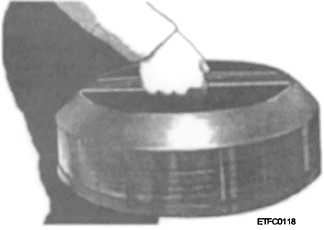Figure 10-1.—A magnetic disk pack.
several gigabytes. An example of a disk pack is
shown in figure 10-1.
Disk cartridges are another form of disk pack
with the heads and head actuator assemblies
contained within a sealed cartridge. Since the disk
pack is never removed from the cartridge, disk
cartridges suffer less contamination problems from
dust and dirt than standard disk packs.
FIXED DISKS.— Fixed disks are small sealed
units that contain one or more disk platters. Fixed disks
are known by several terms, such as Winchester drive,
hard drive, or fixed disk. For clarity, we refer to them as
fixed disks throughout this chapter. Fixed disks are used
in minicomputers and personal computers. They can
also be adapted for use in mainframe computers instead
of having separate disk file units.
Floppy Disks
Floppy disks come in several sizes and densities.
They are called floppy disks because the magnetic
coating is placed on a thin flexible polyester film base.
THE 8-INCH FLOPPY DISK.— The 8-inch
floppy disk was the first disk widely used for
commercial purposes. It is available as both single-
or double-sided and single- or double density. The
8-inch disk is quickly becoming obsolete.
THE 5.25-INCH FLOPPY DISK.— The
5.25-inch floppy disks are used with both personal
computers and minicomputers. The standard double-
sided, double-density disk has a capacity of 360
kilobytes (K). Quad-density disks hold 720K, while the
newest high-density disks can hold 1.2 megabytes (M).
THE 3.5-INCH FLOPPY DISK.— The current
disk of choice is the 3.5-inch floppy disk. These disks
are
also
used
with
personal
computers
and
minicomputers. These smaller disks have data capacities
of 720K for double-density disks and 1.44M for high-
density disks.
ORGANIZING DATA ON DISKS
Before data can be stored on a magnetic disk, the
disk must first be divided into numbered areas so the
data can be easily retrieved. Dividing the disk so the
data can be easily written and retrieved is known as
formatting the disk. The format program divides each
data surface into tracks and sectors.
Tracks — Concentric rings, called tracks, are
written on the disk during the formatting process.
Floppy disks have 40 or 80 tracks per side. Fixed disks
and disk packs can have from 300 to over 1,000 tracks
per side. Figure 10-2 shows an example of how tracks
are written on a disk surface. Each track is assigned a
number. The outermost track on a disk is assigned
number 00. The innermost track is assigned the highest
consecutive number.
Sectors — Each track is divided into sectors.
Sectors are numbered divisions of the tracks designed to
make data storage more manageable. Without sectors,
each track would hold more than 4,500 bytes of
information and small files would use an entire track.
Figure 10-2.—Tracks on a segment of a magnetic disk.
10-3




